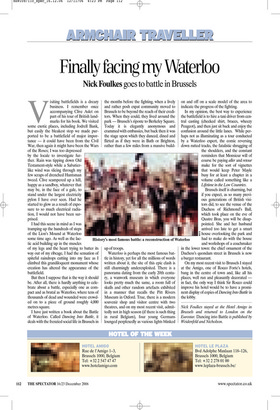Finally facing my Waterloo
Nick Foulkes goes to battle in Brussels Visiting battlefields is a dreary business. I remember once accompanying Clive Aslet on part of his tour of British landmarks for his book. We visited some exotic places, including Jodrell Bank, but easily the bleakest stop we made purported to be a battlefield of major importance — it could have been from the Civil War, then again it might have been the Wars of the Roses; I was too depressed by the locale to investigate further. Rain was tipping down Old Testament-style while a Sabatierlike wind was slicing through my few scraps of drenched Huntsman tweed. Clive scampered up a hill, happy as a sandboy, whatever that may be, in the face of a gale, to stand under the largest electricity pylon I have ever seen. Had he started to glow as a result of exposure to so much electrical radiation, I would not have been surprised.
I had this scene in mind as I was tramping up the hundreds of steps of the Lion’s Mound at Waterloo some time ago. As well as the lactic acid building up in the muscles of my legs and the heart trying to batter its way out of my ribcage, I had the sensation of spiteful raindrops cutting into my face as I climbed this grandiloquent monument whose creation has altered the appearance of the battlefield.
But then I suppose that is the way it should be. After all, there is hardly anything to celebrate about a battle, especially one as compact and as brutal as Waterloo, where tens of thousands of dead and wounded were crowded on to a piece of ground roughly 4,000 metres square.
I have just written a book about the Battle of Waterloo. Called Dancing Into Battle, it deals with the frenzied social life in Brussels in the months before the fighting, when a lively and rather posh expat community moved to Brussels to be beyond the reach of their creditors. When they could, they lived around the park — Brussels’s riposte to Berkeley Square. Today it is elegantly anonymous and crammed with embassies, but back then it was the stage upon which they danced, dined and flirted as if they were in Bath or Brighton, rather than a few miles from a massive build up of troops.
Waterloo is perhaps the most famous battle in history, yet for all the millions of words written about it, the site of this epic clash is still charmingly underexploited. There is a panorama dating from the early 20th century, a waxwork museum in which everyone looks pretty much the same, a room full of skulls and other random artefacts exhibited in a manner that recalls the Pitt Rivers Museum in Oxford. True, there is a modern souvenir shop and visitor centre with two theatres, and on my most recent visit, admittedly not in high season (if there is such thing in rural Belgium), four young Germans lounged perplexedly as various lights blinked on and off on a scale model of the area to indicate the progress of the fighting.
In my opinion, the best way to experience the battlefield is to hire a taxi driver from central casting (checked shirt, braces, wheezy Peugeot), and then just sit back and enjoy the confusion around the little lanes. While perhaps not as illuminating as a tour conducted by a Waterloo expert, the comic reversing down rutted tracks, the fatalistic shrugging of the shoulders, and the constant reminders that Monsieur will of course be paying aller and retour make for the sort of vignettes that would keep Peter Mayle busy for at least a chapter in a volume called something like a Lifetime in the Low Countries.
Brussels itself is charming, but if you expect, as so many previous generations of British visitors did, to see the venue of the Duchess of Richmond’s Ball, which took place on the eve of Quatre Bras, you will be disappointed. She and her husband arrived too late to get a smart house overlooking the park and had to make do with the house and workshops of a coachmaker in the lower town: the chief ornament of the Duchess’s quondam street in Brussels is now a burger restaurant.
On my most recent visit to Brussels I stayed at the Amigo, one of Rocco Forte’s hotels, bang in the centre of town and, like all his places, well run and pleasantly decorated in fact, the only way I think Sir Rocco could improve his hotel would be to have a prominent display of copies of Dancing Into Battle in the lobby.
REX






































































































































 Previous page
Previous page